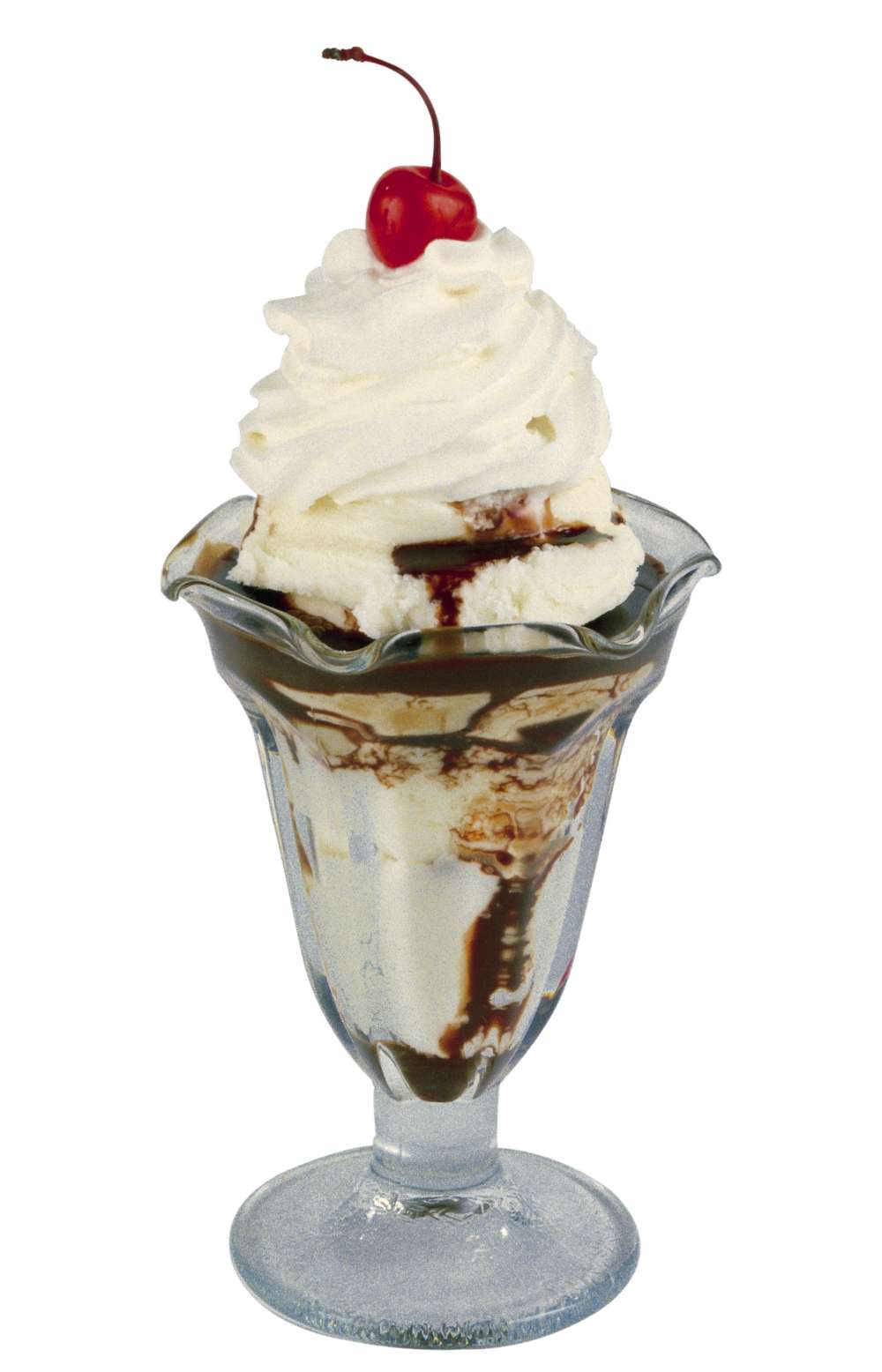Summer vacation might be over, but we can hang onto the season a bit longer. The sundae, America’s favorite summertime dessert, is named for the first day of the week. Typically many of us make quick versions with syrups, sprinkles and cream topping sprayed from a can. We might say they’re “for the kids” but most grownups don’t need much encouragement to indulge in them.
Although children in Europe are wild about ice cream too, many cafes and restaurants there are proud of their sundaes for adults. In France these might be spirited sundaes with orange brandy or kirsch (clear cherry brandy), which the waiter brings in a tiny bottle for you to pour over your ice cream. Coffee, nuts and exotic fruit are other popular “adult” flavors. At good eateries the sundaes are crowned with house-made creme Chantilly–heavy cream whipped with pure vanilla and sugar.
Called simply a “coupe”, the French term for a wide-mouthed stemmed glass, a French sundae can be as basic as ice cream with sliced fruit or as elaborate as the “dessert symphonies” at some restaurants. The most memorable sundae I ever had was served at a French restaurant famous for its splendid “grand dessert”–spoonfuls of just-churned vanilla bean ice cream and intensely fruity sorbets, red berry sauce, perfect fruit, and fresh-baked almond tile cookies and nut macaroons for garnish.
Of course, for quick treats nobody would do all that. But it’s easy to prepare a sundae that’s better than the usual syrup-drenched sort. Indeed, sundaes give us a great opportunity to turn this season’s bounty of fruit into festive finales that can be nutritious as well.
During the years I studied cooking in Paris, I also got practical ideas for homemade sundaes from late-night snacks at Parisian cafes. Often we opted for “Café Liegeois,” made of coffee ice cream cloaked with dark coffee sauce–basically sweetened strong coffee–and Chantilly cream adorned with chocolate coffee beans. Arriving in a “coupe,” this treat was beautiful and enticing. We loved the pure coffee flavor with just the right balance of sweetness and creaminess. For a quick home version, you could use light ice cream and, instead of whipped cream, top the coffee ice cream with a spoonful of softened light vanilla ice cream, and then with the chocolate coffee beans.
Escoffier, the most renowned French chef of the twentieth century, is best known for a sundae–Peach Melba, made of poached peaches, raspberry sauce and vanilla ice cream. It’s easy to find his creation on menus in France and it has been imitated throughout the world. If you use light ice cream or frozen yogurt and make your sauce from fresh raspberry puree (as he did), the dessert is wholesome too, as desserts go, thanks to the nutrient-dense fruit. For a pareve option, substitute raspberry or peach sorbet or soy ice cream for the dairy ice cream.
Chefs frequently name their ice cream creations for a place noted for a key component. We found variations of the coffee classic, such as Le Brésilien, or “The Brazilian”, made with coffee liqueur instead of coffee sauce, and a hot-and-cold Irish Coupe–whiskey-spiked hot coffee with vanilla ice cream.
Island Coupe was another appellation we liked on Parisian café menus, and it featured coconut ice cream, passion fruit sorbet, pineapple and rum. Black Forest Coupe, like the famous cake, combined vanilla ice cream with cherry and chocolate sauces and was dressed up with candied cherries and shaved chocolate. Chestnuts from Correze in central France inspired Correze Coupe–chestnut and vanilla ice creams, cognac-macerated chestnuts and a topping of candied chestnuts. Grenoble Coupe paired nut ice cream with walnuts, the pride of that French city.
Some coupes contained airy-textured cake that absorbed liqueur readily. When we were in the mood for an ice cream feast, we ordered a lavish concoction of rum-soaked savarin (yeast sponge cake), rum-raisin, coffee and chocolate ice creams and chocolate sauce. If I had over-indulged in a rich lunch, I chose a light strawberry sorbet coupe with kirsch-laced ladyfingers, melon balls and toasted almonds
Whether you present these treats in fancy crystal coupes or simple dishes, they are a wonderful way to sweetly end a summer dinner or to pamper your family at midday or midnight. For a personal touch, make your own sauce and use a top-quality garnish. Prepare speedy fruit sauces by pureeing fresh or frozen fruit in a food processor with sugar to taste and a splash of spirits or fruit juice. Cook up chocolate sauce in a flash by melting semisweet chocolate in milk as in the Sabra Sundae recipe below. Decorate your dessert with toasted pecans, grated fine chocolate, chopped candied ginger, fresh berries or chocolate-dipped almonds.
Put together your own scrumptious sundaes from the flavors that strike your fancy, taking advantage of the wealth of ice creams and sorbets available at the market. For a mango coupe, scoop mango sorbet and vanilla ice cream into a pretty dish and surround them with sweetened kiwi puree and mango slices. Make a raspberry-chocolate coupe with raspberry sorbet, fresh berries and chocolate sauce. Pour strawberry sauce around mint ice cream and add nectarine slices and mint leaves for a refreshing mint coupe. Or compose a light “coupe exotique” by matching acai, passion fruit or any other tropical fruit sorbet with papaya, Asian pear, guava, mango sauce and a garnish of starfruit or pineapple. Savor your coupe slowly and imagine you’re relaxing on the terrace of a Parisian café.
Faye Levy is the author of the award-winning book, Chocolate Sensations, and of Fresh from France: Dinner Inspirations. Her latest book is Healthy Cooking for the Jewish Home.
The words of this author reflect his/her own opinions and do not necessarily represent the official position of the Orthodox Union.

